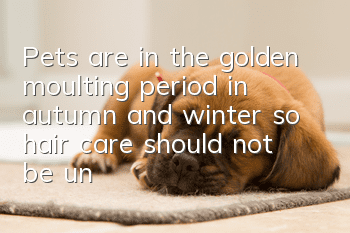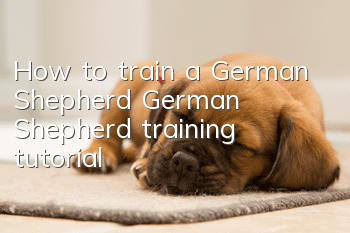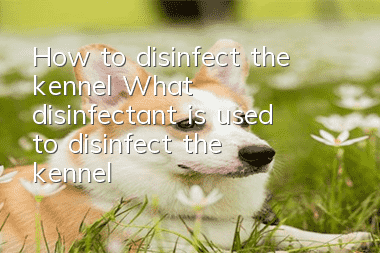Pets are in the golden moulting period in autumn and winter, so hair care should not be underestimated.

For the perception of seasons, pets at home are more sensitive than us. In this crisp autumn season, pets are also entering their golden shedding period. Proper maintenance and grooming of your pet's hair will definitely bring unexpected surprises.
How much do you know about pet hair?
Moulting cycle
Growth stage: There is a tissue called "hair mother" at the bottom of the hair root. This part continues to undergo vigorous cell division to promote hair growth. Migration phase: After the hair root growth stops, the hair root cells gradually die of old age and no longer grow new hairs. Telogen: After the cells die, the hair mother undergoes cell division again and begins to grow new hair.
Moult period
Dog breeds that shed their coat twice a year begin to shed their coat as the seasons change. In the spring, a large amount of the undercoat, which has high thermal insulation properties, is removed, and in the autumn, the upper coat is removed.
Conditions related to coat shedding cycle
There are many types of coat shedding cycles. Because dogs and cats shed their hair once or twice a year, it is called seasonal shedding. If the sunshine time from spring to summer is relatively long, the hair loss rate will be high and the overall coat volume will be reduced so that the skin can contact the air very smoothly. In autumn when the daylight hours are short, although hair loss is easy for a certain period of time, thick new hair will grow quickly to maintain body temperature.
Hormones have the power to determine the shedding of coat. The female hormone "egg hormone" can promote coat development, while the male hormones "testosterone" and "adrenal sebum stimulating hormone" will slow down the growth rate of coat. In addition, "thyroid hormone" is closely related to the growth of dog hair. If thyroid hormone is insufficient, hair loss will continue to occur. Especially for female dogs, the hormonal balance during or around the time of giving birth will determine the hair loss. Therefore, there will be a tendency at this time that hair loss will not necessarily occur with the changes of the seasons.
Points to note when dealing with pet dog hair knots
The traditional method of combing the coat of a pet dog can easily cause the hair to become tangled and form hair balls, causing pain to the pet dog, and it cannot meet the needs of the pet for styling and trimming. The beautician should cooperate with the dog's knotted condition, select tools according to different knotted parts, and master scientific methods.
When removing a dog's hair knots, the beautician needs to be flexible and familiar with various tools and the causes of hair knots, choose the correct tools, and pay attention to the dog's feelings during the operation to avoid causing pain to the dog.
How much do you know about pet skin?
The difference between dog and human skin
In terms of pH value, the pH value of human skin is 5.0 to 6.0, and the pH value of dog skin is 6.0 to 8.0 (rising to around 9.2 in summer). Dogs are slightly higher than humans. Because there is no body temperature regulation function, dogs secrete very little sweat. Therefore, dogs' sweat glands are not as developed as humans and cannot rely on sweat glands to sweat. They regulate body temperature by breathing with their mouths wide open. Because of this, and being covered in a lot of coat, they can easily pick up dust and dirt, making them susceptible to skin diseases.
Tips on pet skin
From the surface of the skin, we can know that the skin is composed of three layers of materials: epidermis, dermis, and subcutaneous tissue. The outermost epidermis of the skin is composed of four layers: the stratum corneum, the granular layer, the spinous layer, and the basal layer. One in 10 cells in the basal layer is a melanocyte.
The stratum corneum is the outermost layer and serves to prevent dryness and protect the body from external invasion. In the stratum corneum, keratinocytes, which are mainly composed of keratin, overlap very regularly and contain 10 to 20% water. Between the horny cells, [intercellular lipids] centered on wheat germ oil and water containing natural moisturizing factors are cross-arranged and fill the gaps in the horny layer, thus preventing evaporation of water and foreign matter from the outside. Invasion.
Autumn pet hair care and grooming
In the dry season of golden autumn, it is important to moisturize pet hair both internally and externally. For internal care, pets can be strengthened by supplementing vitamins and appropriate amounts of omega-3 deep-sea fish oil; for external care, choosing the appropriate bath solution and regular SPA care can moisturize the skin, prevent dryness, remove dead hair, and enhance fragrance retention.
Omega-3 fatty acids are vital to your pet’s health. Our beloved dogs and cats are unable to produce omega-3 on their own, so they need supplementation from other sources.
Special salmon oil for pets can enrich their daily diet and keep them healthy at all times.
Special reminder: Pet hair should not be shaved. Pet hair is the most powerful protective layer on the outer layer of pet skin. After shaving, it will cause serious damage to pet skin, damage to hair follicles, direct ultraviolet rays to the skin, mosquito bites, psychological depression, low self-esteem, and social impact. Before the cold winter comes, prepare fur for pets to keep them warm.
- Where does the Manchester Terrier originate from?
- Dog's nose is dry
- Can dogs laugh?
- Can dogs use Levofloxacin eye drops?
- What to do if your dog’s hair becomes tangled?
- Symptoms and treatment of parvovirus in Bichon Frize
- An in-depth analysis of five common dog behaviors
- What should I do if my golden retriever chews the furniture at home? Dog owners, look over here!
- Prevent your dog’s five major health risks
- How do novices raise Corgis? Daily feeding methods for Corgis!



